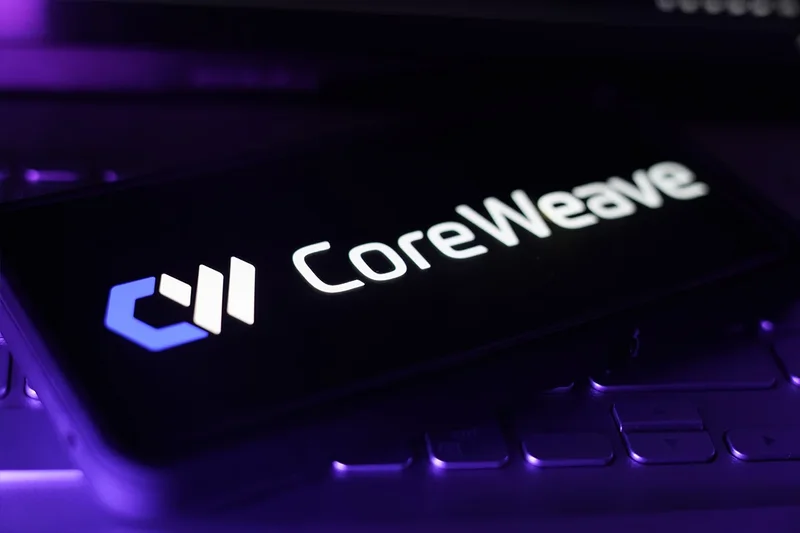Generated Title: CoreWeave's Wild Ride: Is This AI Darling Overhyped?
CoreWeave (CRWV) has been the AI infrastructure darling of 2025, but its recent pullback raises a critical question: Is the hype outpacing reality? The company, barely public since March, has seen its stock surge over 100% year-to-date, fueled by insatiable demand for AI compute. But a lowered 2025 revenue outlook—from $5.25 billion to $5.1 billion—triggered a near 30% stock drop. This isn't just a blip; it's a potential crack in the narrative.
The Backlog Mirage
The bullish argument hinges on CoreWeave's massive backlog: $55.6 billion in Q3, up 85% from the previous quarter. Impressive, right? But let's dissect that number. It includes $22.4 billion from OpenAI and $14.2 billion from Meta (META), running through 2031. These are substantial commitments, no doubt. However, backlog isn't revenue. It's a promise of future business, and promises can be broken (or, more likely, renegotiated).
Compass Point analyst Michael Donovan points to Nvidia's (NVDA) support as a key strength. Nvidia owns about 7% of CoreWeave and has a $6.3 billion capacity guarantee. This is framed as ensuring revenue even for unused GPUs. But consider the other side: Nvidia essentially has a put option on CoreWeave's capacity. If demand falters, Nvidia is on the hook, which limits their upside but protects their investment. This guarantee might signal more about Nvidia's need to secure its own GPU sales than CoreWeave's inherent strength.
J.P. Morgan analyst Mark Murphy downgraded the stock to Hold, citing supply issues that pushed revenue into later quarters. He notes new customer wins (CrowdStrike, Rakuten, etc.), indicating ongoing demand. But here's the rub: everyone is winning new customers in the AI space. The question isn't if you're growing, but how fast and at what cost.
Data Center Capacity vs. Reality
CoreWeave touts its expanding data center capacity. They had 590 megawatts (MW) of active data center power across 41 data centers in Q3, up from 470 MW across 33 data centers in Q2. Contracted capacity jumped to 2.9 GW from 2.2 GW. Management estimates bringing over 1 GW of contracted capacity online in the next 12-24 months.

This growth is presented as a slam dunk. But here's where I get skeptical. (I've looked at hundreds of these filings, and the ramp-up from contracted to active capacity is rarely seamless.) These are just plans. Turning contracted capacity into revenue-generating data centers requires execution, and that's where delays and cost overruns often lurk. What is the average time between contracted and active capacity? What are the capital expenditures required to bring this capacity online? These numbers are conspicuously absent.
The reduced revenue guidance, attributed to "temporary delays related to a third-party data center developer," should be a red flag. CEO Michael Intrator assures investors that the customer has agreed to adjust the delivery schedule and extend the expiration date, keeping the original contract value intact. But this “adjustment” probably came at a cost (perhaps lower rates, or more favorable terms), which isn't fully disclosed.
One source claims CoreWeave's backlog is nearly twice the cumulative revenue analysts expect over the next two years. The article optimistically projects CoreWeave's revenue growing at 36% annually, reaching $46 billion by the end of the decade, leading to a market cap of $414 billion. This projection relies on a price-to-sales ratio of 9. But what justifies that multiple? The tech sector is volatile, and relying on current ratios for five-year projections is a dangerous game.
The anecdotal data from online communities is mixed. While some see CoreWeave as a "generational buy," others worry about the concentration of revenue from a few key clients. The sentiment seems to be shifting from unbridled enthusiasm to cautious optimism. As one article points out, CoreWeave: This Isn't The Bubble Pop, Yet (NASDAQ:CRWV), it may be too early to call this a bubble pop.
A Calculated Gamble, Not a Sure Thing
CoreWeave is undoubtedly in a hot sector. The demand for AI infrastructure is real. However, the current valuation seems to bake in near-perfect execution and continued exponential growth. The lowered revenue outlook, coupled with the lack of transparency around data center build-out costs and timelines, suggests a riskier proposition than the market currently acknowledges.
